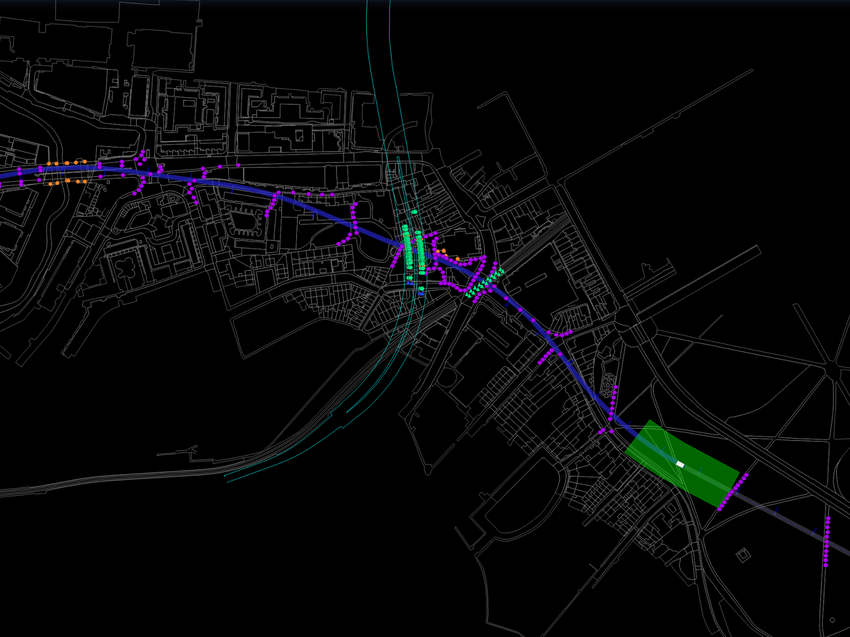GEO-Instruments, has successfully completed its monitoring works on behalf of HOCHTIEF-MURPHY Joint Venture (HMJV) for the National Grid’s London Power Tunnels (LPT) Phase 2 scheme, an overall £1 billion investment to futureproof South London’s power network.

LPT Phase 2 consists of more than 30 kilometres of new cable tunnels stretching from Wimbledon in South West London to Crayford in the South East. The tunnels will carry high voltage cables that will replace existing older circuits.
At the end of September, HMJV, main contractor for the tunnelling and shafts package completed the scheme’s final tunnel drive.
In the following weeks GEO-Instruments survey teams completed their last shifts on the project, undertaking a final monitoring survey at the project’s Eltham site after more than two years of daily manual and automated monitoring of multiple concurrent tunnel drives.
GEO-Instruments were responsible for supporting HMJV in a large and complex monitoring scheme that covered the entire length of the project throughout construction. Monitoring needed to include surface monitoring along the course of the new tunnels, the access shaft sites and multiple third-party assets.
In addition to more than 1400 daily levelling surveys, the GEO-Instruments survey team undertook over 150 night shifts to carry out instrumentation installations and subsequent monitoring surveys.
Ken Critchley, Project Manager for GEO-Instruments, said: “It has been a privilege to be a part of LPT Phase 2. The project has been an exciting challenge for us and I am proud of what we’ve achieved working as part of the HMJV team”
A range of automated and manual solutions were installed to monitor road infrastructure and the various third party assets that cross the routes of the tunnel boring machines (TBMs).
By the end of tunnelling, four TBMs had completed five separate tunnel drives and had crossed under 17 critical rail assets operated by Network Rail, London Underground and Docklands Light Railway.

Each interface had unique monitoring requirements that had to be met to allow tunnel construction to proceed without delays.
Certain assets required engineers with specialist access training in order to complete instrument installs and surveys.
Over the course of the project GEO-Instruments installed, surveyed and monitored:
- Levelling arrays consisting of more than 3500 Precise Levelling Points installed into roads, pavements and other surfaces.
- More than 600 3D monitoring prisms and retro reflective targets for monitoring of bridges, viaducts, tunnels and tracks.
- ShapeArrays and Wireless Tiltmeters networks to measure track or tunnel deformation.
- Hydrostatic Levelling Cells to precisely measure settlement and Optical Displacement Sensors to monitor convergence in access shafts, tunnels and other third party stakeholders, such as UK Power Networks.
- Arrays of 3D monitoring targets on listed structures such as bridges or churches.
- Track geometry and clearance surveys of TfL assets pre- and post-TBM passage.
- Tunnel and trackside condition surveys of NWR and LU assets.



The monitoring package also included the supply of cloud-based visualisation software to display all manual and automated monitoring data in almost real time, generate reports and provide live tracking of TBM progress.
The QuickView software, developed in-house by GEO-Instruments, enabled HMJV teams to effectively manage project monitoring data. Several new QuickView features were developed on demand specifically for the LPT Phase 2 project. These bespoke-designed tools helped the project team to understand the influence of daily tunnel construction on all monitored assets across the route simultaneously.
Overall, the tunnelling project and the monitoring scheme have been a great success, with strong cooperation between HMJV and GEO-Instruments allowing all stages of monitoring and construction to run smoothly.
The volume and complexity of works required careful planning to organise access and get essential paperwork in place ahead of expected lead times, helping to avoid delays to the programme.
Good relationships between GEO-Instruments, the contractor, and asset holders like London Underground made organisation of critical works straightforward and efficient.
Piotr Konieczny, General Manager of GEO-Instruments said: “It’s incredibly rewarding to complete a project like this. We are thrilled to have helped deliver the shaft and tunnelling works on time, with a satisfied client, a happy team, and some great new features developed for our QuickView software that make our platform a better tool for any future tunnelling job”.
The new power infrastructure is expected to be fully operational by 2027. Find out more about earlier stages of the project.